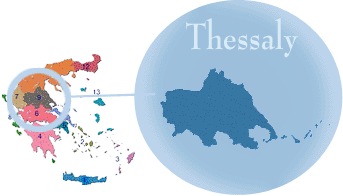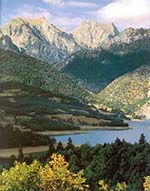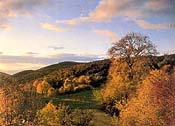
Thessaly (Thessalia) is the geographical department that occupies the central section of mainland Greece. It is surrounded by high mountain ranges encircling a low plain. It borders Macedonia to the north, Sterea Ellada to the south, Epirus to the west, and its eastern shoreline is on the Aegean. It has a higher percentage of flatland than any other district in Greece.  The climate is continental; the winters are cold and the summers hot and the temperature differential between the two seasons are large. One of the characteristics of the climate of the plain of Thessaly are frequent summer rainstorms. These frequent rains amplify the fertility of the plain, often called the breadbasket of Greece.
The climate is continental; the winters are cold and the summers hot and the temperature differential between the two seasons are large. One of the characteristics of the climate of the plain of Thessaly are frequent summer rainstorms. These frequent rains amplify the fertility of the plain, often called the breadbasket of Greece.
The entire plain is surrounded by the mountains Pindus, Othrys, Ossa, and Agrafa; among them flows the Pinios river which
drains into the Aegean, after passing through the Thessalic Tempi. The district was the home of the ancient gods and of the
Centaurs. Here, in this place among the woods, the gorges, and the picturesque villages, Meteora reach for the sky. Twenty four Byzantine monasteries have been clinging to the tops of the tall grey rock shafts for over six hundred years, challenging and inviting pilgrims and visitors from all over Greece to this centre of Christianity.  Larissa is the capital of Thessaly: Old mansions with yards and gardens in bloom in the middle of the plain of Thessaly. Amid the proud mountains and traditional villages, the visitor will find spas, churches, and antiquities.Karditsa, the capital of the district of Karditsa, is built on the banks of a tributary of the Pinios river. A modern town with well laid-out streets, it is at the same time especially picturesque with its traditional villages scattered on the peaks of the Agrafa mountain range. Spas at Smokovo and Kaista as well as many antiquities and Byzantine monuments Built on the site of Homeric Trikki, Trikala today is crossed by the river Litheos. The ruins of the most ancient sanctuary of Asclepius are here.Kalambaka, famed for its Byzantine churches, is built where the river Pinios leaves the Pindus mountains, at the foothills of Meteora. Nearby the Pagasitic gulf embraces Pelion, the mythological land of the Centaurs: imposing and verdant, rough and scenic, wild and accessible. With beech covered peaks, streams running down the slopes, villages rooted among the chestnut and olive trees, Pelion is a wonder. Makrinitsa, Portaria, Milies, Vizitsa, Tsagarada, Zagora : magnificent large old stone houses with wall decorations and slate roofs.
Larissa is the capital of Thessaly: Old mansions with yards and gardens in bloom in the middle of the plain of Thessaly. Amid the proud mountains and traditional villages, the visitor will find spas, churches, and antiquities.Karditsa, the capital of the district of Karditsa, is built on the banks of a tributary of the Pinios river. A modern town with well laid-out streets, it is at the same time especially picturesque with its traditional villages scattered on the peaks of the Agrafa mountain range. Spas at Smokovo and Kaista as well as many antiquities and Byzantine monuments Built on the site of Homeric Trikki, Trikala today is crossed by the river Litheos. The ruins of the most ancient sanctuary of Asclepius are here.Kalambaka, famed for its Byzantine churches, is built where the river Pinios leaves the Pindus mountains, at the foothills of Meteora. Nearby the Pagasitic gulf embraces Pelion, the mythological land of the Centaurs: imposing and verdant, rough and scenic, wild and accessible. With beech covered peaks, streams running down the slopes, villages rooted among the chestnut and olive trees, Pelion is a wonder. Makrinitsa, Portaria, Milies, Vizitsa, Tsagarada, Zagora : magnificent large old stone houses with wall decorations and slate roofs.
Beautiful resorts dot the seaside.Volos, the capital and economic centre of the district, is located in the Pagasitic gulf. Its verdant surroundings are alive with ancient memories; lolkos (the hide-out of Jason and the Argonauts), Dimitrias.
To the west are the neolithic settlements of Seklo and Diminio. Splendid blue waters lap at beautiful beaches and local specialities complete the region's portrait.

